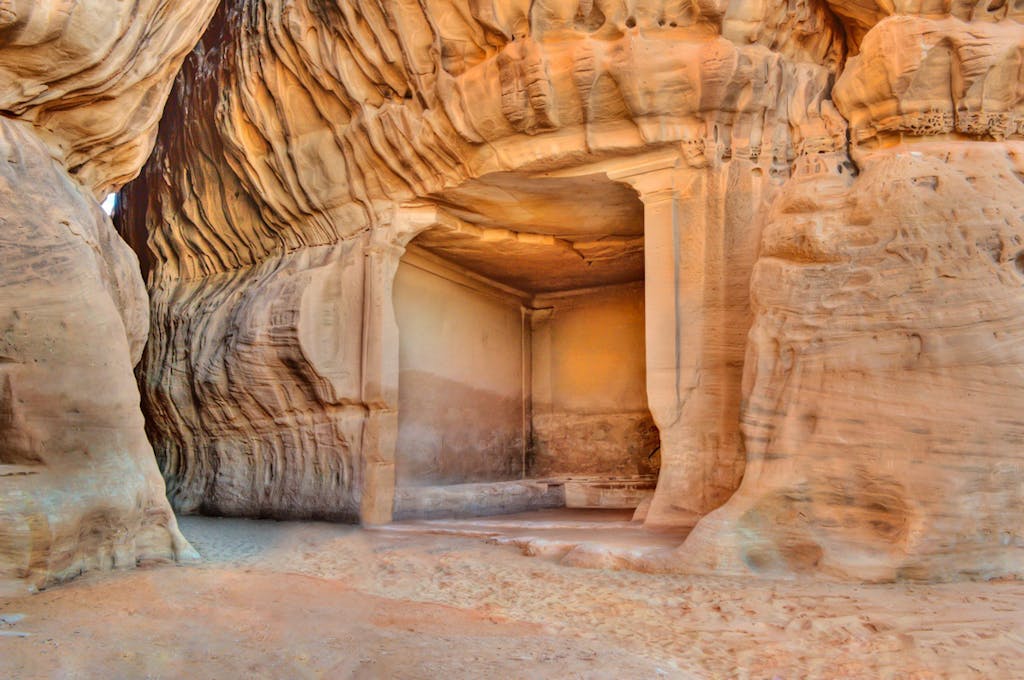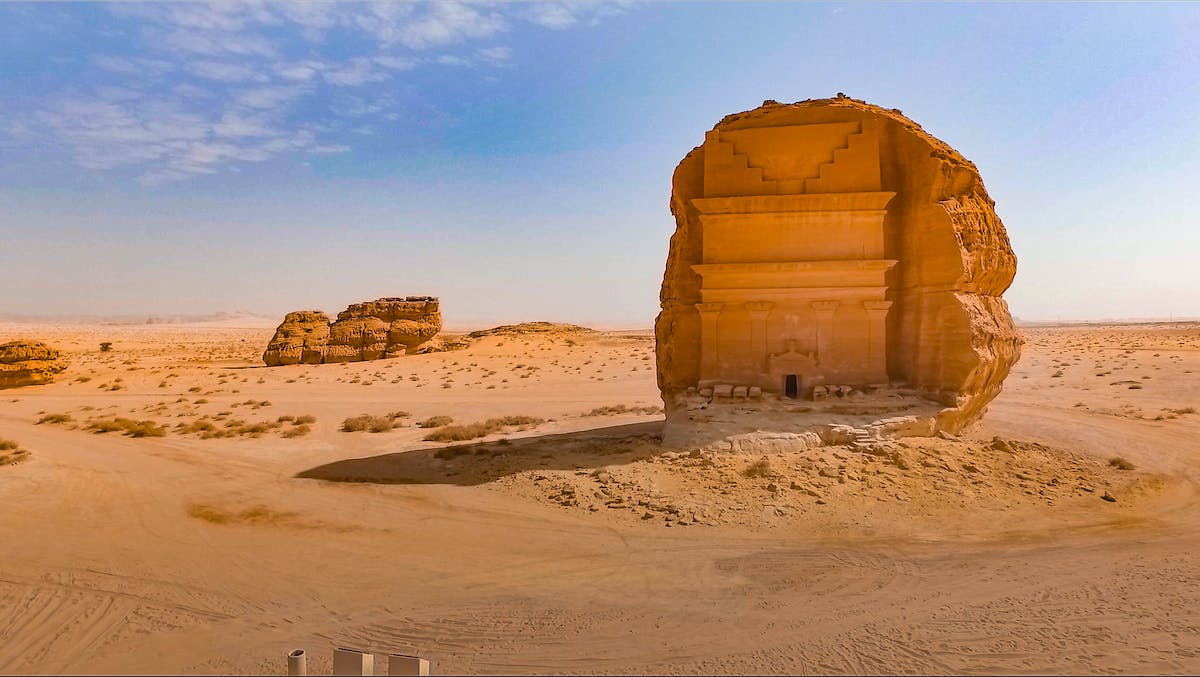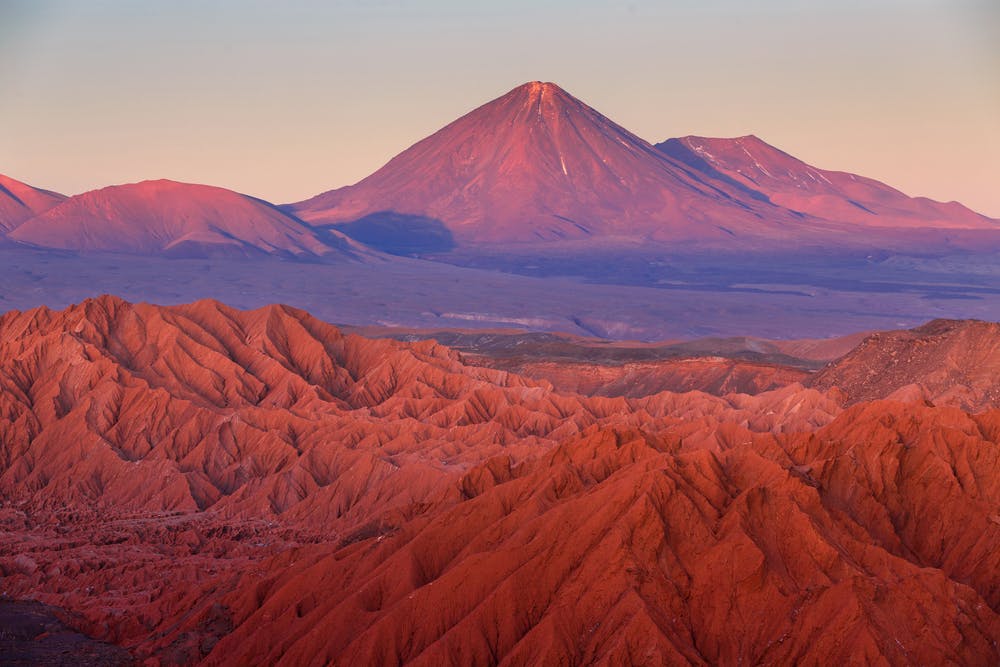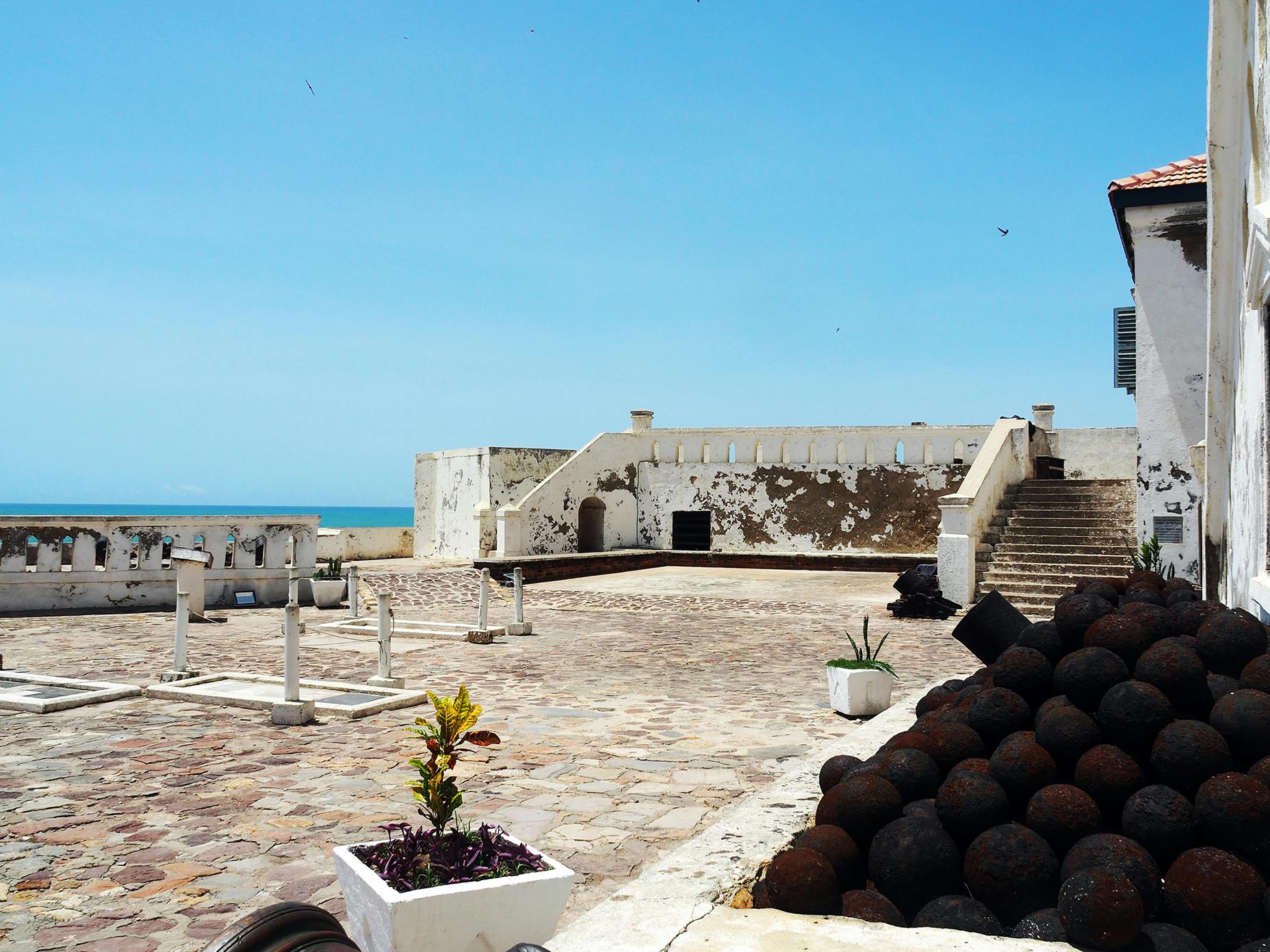Uncovering the Ancient Wonders of Alula, Saudi Arabia
On a velvety, star-studded night in the middle of the Arabian Desert, I join a glittering group of VIPs in a venue just as dazzling: the Maraya Concert Hall, the largest mirrored building in the world. Sprouting dramatically from the arid landscape, Maraya shimmers like a mirage, as surreal as the AlUla region that surrounds it.
As we nibble truffled mac ‘n’ cheese, steak tartare with caviar and squid from the Red Sea, we celebrate the opening of Maraya Social, the concert hall’s open-air rooftop restaurant helmed by acclaimed British chef Jason Atherton, who wants to “put AlUla on the map as a foodie destination.”
Star-powered cuisine isn’t the only thing to put AlUla on the international tourist map. Indeed, this northwestern Saudi Arabia area that not many people are familiar with is being transformed into a showstopping destination for Saudi Arabian culture, art and heritage. I’m here as part of a small international group of journalists invited by the government to see it for the first time. Consider that the country only started issuing tourist visas in late 2019 and then COVID kept visitors away for the next two years.

Did I expect to find a chef — whose most recent restaurant earned a Michelin star — in one of the most closed countries on Earth? Hardly. Or more than 100 head-turning megalithic tombs at least 2,000 years old rising from the desert floor like silent sentinels? Not at all. Or an oasis of 2.3 million date palms set in an otherworldly landscape of towering sandstone outcrops to rival Utah’s Red Rocks? Never.
In fact, it’s the yin-yang of antiquity and modernity — leapfrogging centuries, and amid serious eye candy — that stops me in my tracks. Not to mention the heartfelt hospitality and enormous pride of place expressed by everyone I encounter. And the sense that I’m witnessing a nation in transition, one that was literally shrouded from the outside world until recently.
The riches of AlUla are on full display for guests on some Silversea expedition cruises. Shore excursions — like the two-day AlUla Overnight Tour from the Red Sea port of Al Wajh — are available on select Silversea cruises that stop in Saudi Arabia.
The crown jewel of Saudi Arabia
Start with AlUla’s ancient treasures. Located on the historic trade and pilgrimage routes between Arabia and the Mediterranean, its archaeological sites and age-old dwellings make it the world’s largest living museum — about the size of New Jersey. Boasting 200,000 years of largely unexplored human history, it’s now the focus of an audacious $32 billion project to turn it into a tourist showpiece that helps diversify the economy as part of Saudi Vision 2030. New cultural venues (incense museum, anyone?) are in the works. Boldface entertainers are following the likes of Andrea Bocelli and Lionel Richie with concerts at Maraya. Eco-lodges and luxury resorts — including one designed by Pritzker Prize-winning French architect Jean Nouvel, which will be carved right into the ancient sandstone cliffs — are coming in the future. “AlUla is the crown jewel of Saudi Arabia,” Atherton tells me.
The most famous gem is the 2,000-year-old remains of Hegra — sometimes called “the other Petra.” On a blazingly hot, sunny morning, we pile into white Land Cruisers and head to Saudi Arabia’s first UNESCO World Heritage Site. On the way, I watch the massive outcrops and boulders — etched by millennia of wind, rain and sand — strut and swagger across the desert plain.
Hegra, a key trade hub on the legendary incense and spice route, was the Nabateans’ second-most important city after its more famous sibling, Petra, in Jordan. It’s littered with 111 monumental tombs, remarkably carved into the sandstone crags from the top down so no scaffolding was needed. As we admire one chiseled tomb after another, some with accessible interior chambers, our guide Adek points out the Greek columns, Egyptian lotus motifs, Roman eagles and even a snake-bedecked Medusa that adorn the facades. These decorative elements reflect the many cultural cross-currents during the 200-year Nabatean Kingdom. Adek also shows us an intact tomb that was discovered as recently as 2016 with 80 mummified bodies, one wearing a necklace of dates that were once used as currency here.

By late afternoon we arrive at Hegra’s most iconic symbol: the Tomb of Lihyan son of Kuza, which stands isolated from the rest. The setting sun bathes the tawny, 72-foot-tall monolith with a golden glow that radiates over the entire rock-strewn landscape. In the serene silence, I pinch myself at having such a world-class monument all to ourselves — which gives me a rare, Indiana Jones-like sense of discovery.
“We are lucky because this place is magical,” Adek says. “My family farm is just behind it and we used to visit. When we learned about it, it became even more special. Everything changed for us when we learned about it from the archaeologists who taught us,” he says of the training he received.
Strolling through Old Town
The next morning, another guide, Suleiman, walks us through the “open-air library” of Jabal Ikmah. Hundreds of pre-Arabic inscriptions — written in Aramaic, Dadanitic, Thamudic, Minaic and Nabatean — and petroglyphs of humans, animals and musical instruments cover the weathered rocks of a narrow canyon. “This is a sacred mountain,” Suleiman tells us of his favorite place in AlUla. “I’ve been here two years and every day I learn something new.”
Traditionally clad young Saudis like Adek and Suleiman are not only helping launch tourism here, but they’re also discovering a newfound pride in their country and heritage. Their enthusiasm is infectious.
One infectiously fascinating place is the 12th-century mudbrick AlUla Old Town, once at the crossroads of the ancient Incense Route. As I wander the narrow labyrinthine streets of this cramped medieval town, I’m amazed that it was occupied as recently as the 1980s. That’s when the townspeople abandoned it for more modern houses nearby. The 950 crumbling adobe buildings are now being carefully restored by an international team of archaeologists and reborn as lively cafes, gift shops and, soon, a boutique hotel.
“It’s an amazing heritage. It’s exciting,” says Ingrid Périssé-Valéro, director of archaeology and heritage for AlUla, during a traditional lunch of garlic- and cinnamon-flavored sweet potato soup; watermelon salad with dried yogurt, goat cheese and date molasses; fried camel and lamb meatballs with tahini sauce; and stuffed grape leaves.
“We’re finding Neolithic artifacts and ancient structures from the Bronze Age in the oases,” she says from our perch overlooking town. I watch as locals stroll and stop for cardamom-flavored Arabic coffee in the outdoor cafes along a pedestrian street that was in ruins just a year ago. “It’s the most important hub of archaeological objects in the Arabian Peninsula,” she adds. “And we’re just at the very beginning.”

Modernity coming to Saudi Arabian culture
Meanwhile, modernization in the deeply conservative Muslim kingdom continues apace, most notably for women. Since 2018, they can drive and use taxis by themselves — and as of January this year, even become taxi drivers themselves. Although they’re no longer required to wear the long black abaya gown, the hijab headscarf or the niqab face covering, most women I see still wear them. To encourage tourism, the government only requires foreign women to dress modestly and cover their shoulders and knees. Indeed, my packed headscarf goes untouched. Airports still maintain separate security screening for men and women. But in recognition of women’s evolving role, the National Museum in Riyadh spotlights contemporary female artist Taghreed AlBagshi, whose works celebrate women’s right to drive and their empowerment through the professions.
Such change is playing out in the tourism sector, too. Hotelier Oliver Ripley, who just opened one of his chic Habitas eco-retreats in AlUla, tells me that the Saudis relented when he insisted on installing the same pool and gym for both men and women, instead of the traditional separate facilities. “Coming here, I realized I was close-minded,” he says. “I’ve been amazed and surprised by young Saudis. They’re so proud to be Saudi at this moment of change.” Like Ahmed, whose family came from AlUla Old Town and who now guides tourists for a living. As we stroll the dusty, date palm-lined Dadan Heritage Trail, he tells me about his colleague who was once a camel herder and now has a master’s in tourism. “We have the same goal — to share AlUla with the world,” he says. With such admirable ambition, he and his young compatriots may be well on their way.
Ready to start exploring AlUla and Saudi Arabian culture as part of a Silversea cruise? Start by exploring these Africa and Indian Ocean cruises.



















